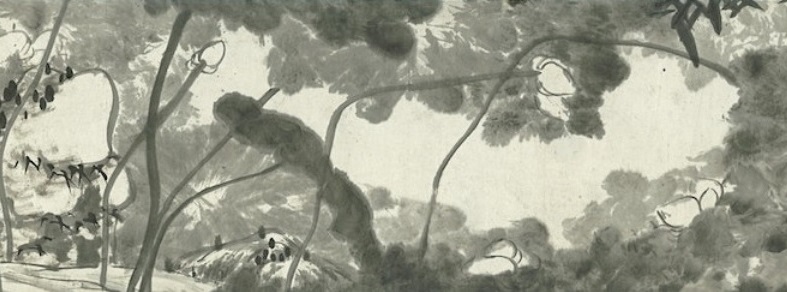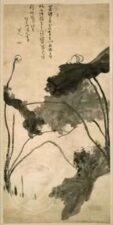China Institute Gallery’s “Flowers on a River” (video 3:25 skip ad)

Zhu Da
Chinese, 1626-1705
Flowers on a River (detail), 1697
ink on paper, hand scroll
18 ½ x 508 ¾ in.
Tianjin Museum

Huang Anping - Portrait of Zhu Da 1674 (detail), hanging scroll, ink on paper, Bada Shanren Memorial Museum, Nanchang
"The blossoms of that lotus have no fragrance;
Its long stalks will hold no wine cups.
What may it become if it drinks not for a hundred years?
The time will come when it will bear new roots of amber yellow." - Zhu Da
In Zhu Da’s paintings, as in his poetry, images of nature are metaphors of thought and feeling. A lotus plant is the theme of an ink painting, dated c. 1685–94. An inscription below the poem indicates that Zhu Da was emulating the late Ming painter Xu Wei (1521–93) who also had a tragic life … Zhu Da's "Lotus" echoes Xu Wei’s ink painting, "Flowers in Four Seasons", which creates a somber mood with splashes of black ink and is inscribed with a poem revealing a stinging political criticism. (When Zhu Da was barely twenty, the Ming dynasty (1368–1644) fell to the Manchus, who established themselves as the next rulers of imperial China, called the Qing dynasty (1644–1911). The lotus – a conventional symbol of purity – here becomes a desolate metaphor of the Middle Kingdom, devoid of fragrance, celebration and life – Zhu Da’s only consolation is that one day a native dynasty – symbolized by the amber yellow wine – will emerge and China will be restored.)
- Mae Anna Pang, Zhu Da: the mad monk painter, Art Bulletin of Victoria, v. 25, June 2014
https://www.ngv.vic.gov.au/essay/zhu-da-the-mad-monk-painter/

Zhu Da - Lotus: homage to Xu Wei, c. 1689–90, Museum of Fine Arts, Boston
COMMENTS
China Institute Gallery—renowned for its thematic exhibitions of Chinese art and the only museum in the U.S. to exclusively show Chinese art—will reopen to the public on March 23, 2023, with a landmark exhibition of Chinese flower-and-bird paintings. The largest survey of its kind outside of China and the first in the U.S., Flowers on a River: The Art of Chinese Flower-and-Bird Painting, 1368-1911, Masterworks from Tianjin Museum and Changzhou Museum will showcase masterpieces of Chinese painting across five centuries. The exhibition will be on view through June 25, 2023. The exhibition marks the first showing of masterpieces traveling from China to the U.S. since the onset of the pandemic. ...
One of the highlights of the exhibition is the Qing dynasty hand scroll Flowers on a River, 1697, from which the exhibition takes its name. The 42-foot horizontal scroll by one of the greatest artists in Chinese history, Zhu Da (1626-1705), also commonly known as Bada Shanren, is considered a masterpiece of Chinese painting—last seen outside of China in the 2013 exhibition Masterpieces of Chinese Painting 700-1900 at the Victoria & Albert Museum in London.
A prince in the imperial Ming family, the enigmatic Bada Shanren went into hiding at a Buddhist temple and became a monk after the Manchu conquest of 1644. In 1680, he began a career as a working artist excelling in painting and calligraphy. His epic scroll Flowers on a River, painted when he was 72 years old, depicts the lifespan of a lotus flower from a seedling to blossoms—faded into a landscape, which holds many secret codes related to his life journey. As the master of individualism, both meditative and joyous, his free and loose brushwork anticipates abstraction by hundreds of years.
“Bada Shanren pushed the expressive possibilities of monochrome ink and brush to the extreme, resulting in incredibly rich effects with an unmistakable individual character,” said Willow Weilan Hai. “No one in the past has ever reached his level of achievement in this regard, and probably few after him will.”
Flowers on a River will travel to the Santa Barbara Museum of Art, on view from October 15, 2023 to January 14, 2024.
- Willow Weilan Hai et. al., Orientations, China Institute Gallery, New York, 2023
https://www.orientations.com.hk/other-events/flowers-on-a-river-the-art-of-chinese-flower-and-bird-painting-1368-1911
Zhu Da (朱耷), was a Chinese painter and calligrapher. He was of noble lineage, being a descendant of the Ming dynasty Prince of Ning (寧王) Zhu Quan (朱權).
A child prodigy, Zhu Da began painting and writing poetry in his early childhood. After the collapse of the Ming dynasty, Zhu Da became a Buddhist monk in 1648. Possibly the fall of that dynasty and the death of his father at about the same time caused him some psychic disturbance, and he may have hovered between real insanity and impassioned creativity. He eventually left the Buddhist cloister and exhibited wildly erratic behavior—such as writing the character for “dumb,” and attaching it to his door and then refusing to speak.
In his paintings, usually in ink monochrome, such creatures as birds and fishes are given a curious, glowering, sometimes even perverse personality. He used an abbreviated, wet style that, while deceptively simple, captures the very essence of the flowers, plants, and creatures he portrays. His flower-and-bird paintings, executed in the “sketching ideas (寫意, xieyi)” style, were influenced by Chen Chun (陳淳) and Xu Wei (徐渭) of the Ming. He also painted landscapes in a dashing shorthand inspired by the 10th-century masters Dong Yuan (董源) and Juran (巨然). Unlike most Chinese painters, he does not easily fit into any traditional category; in character and personality he was the complete eccentric and “individualist.”
- China Online Museum, 2023
https://www.comuseum.com/painting/masters/zhu-da/
